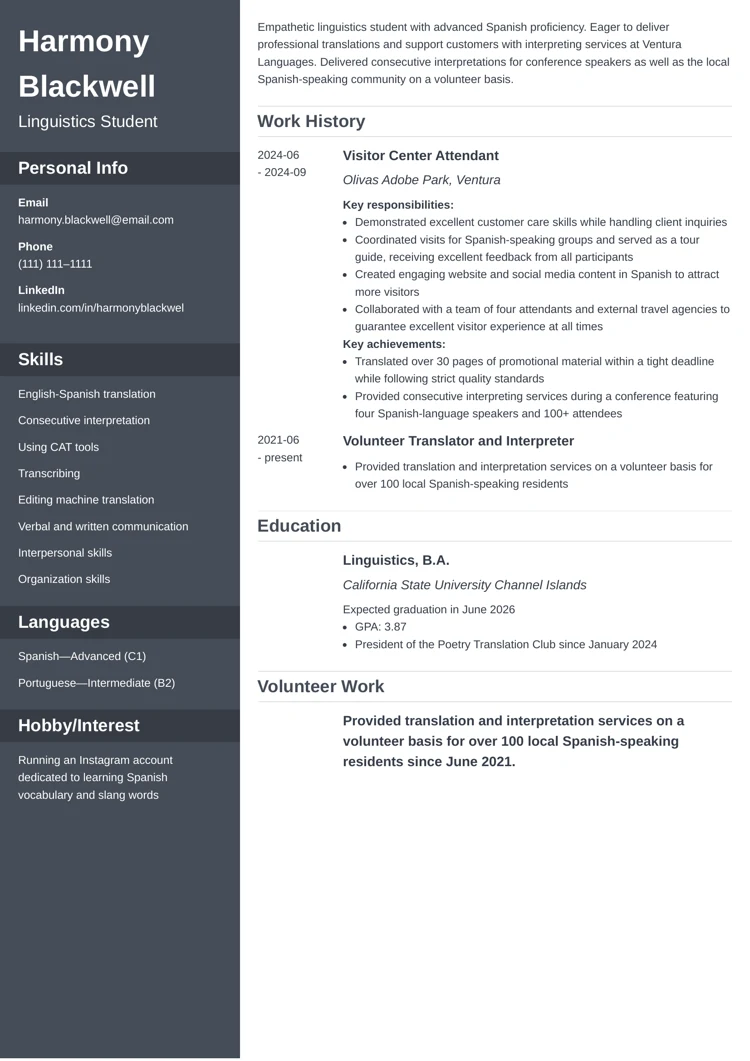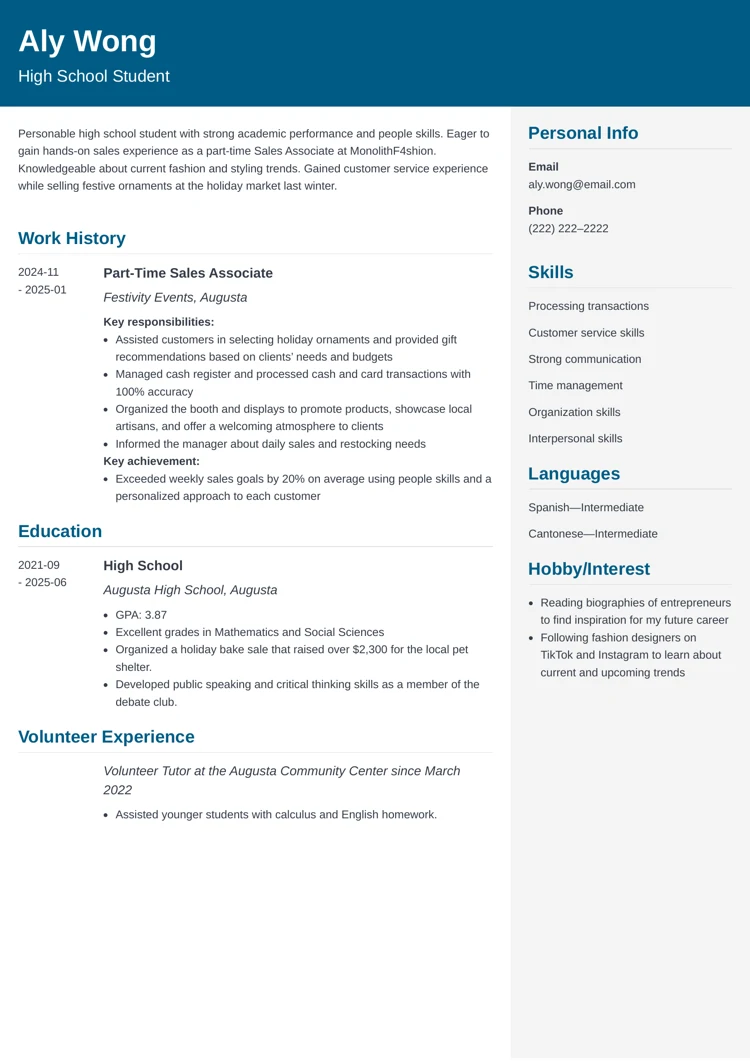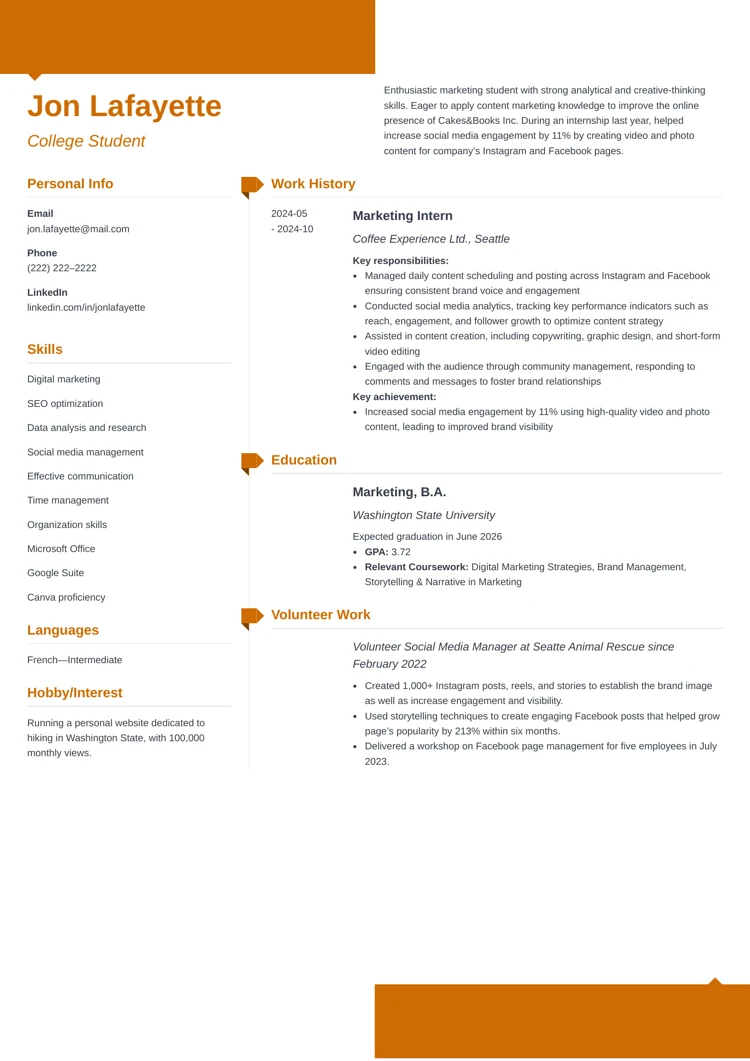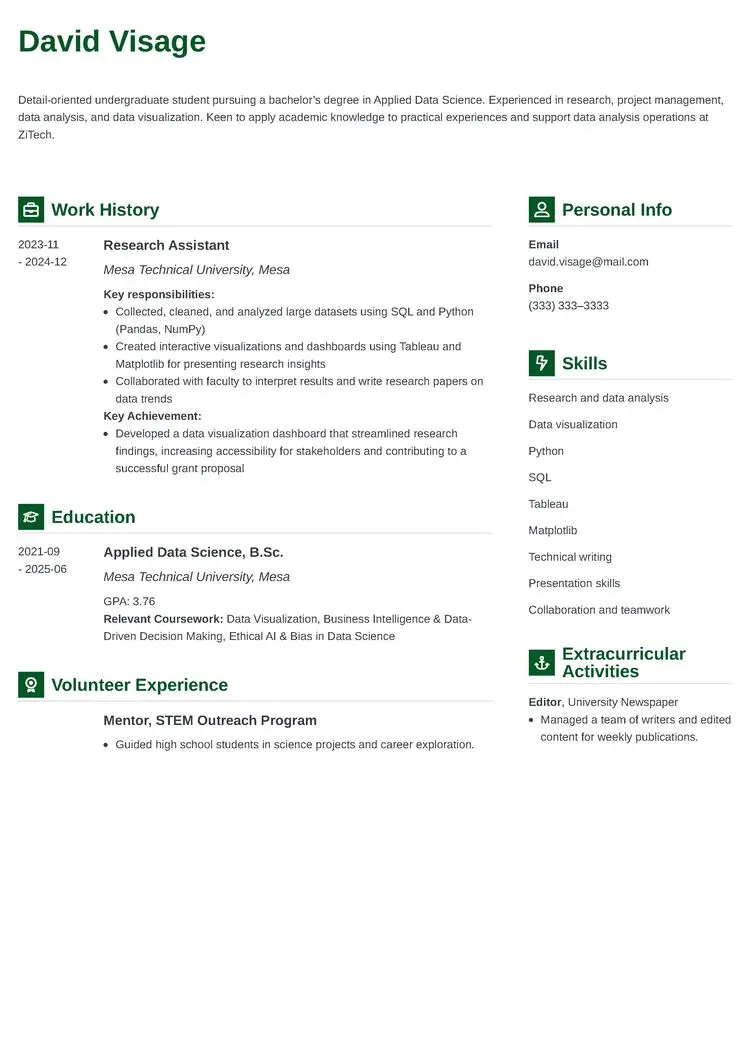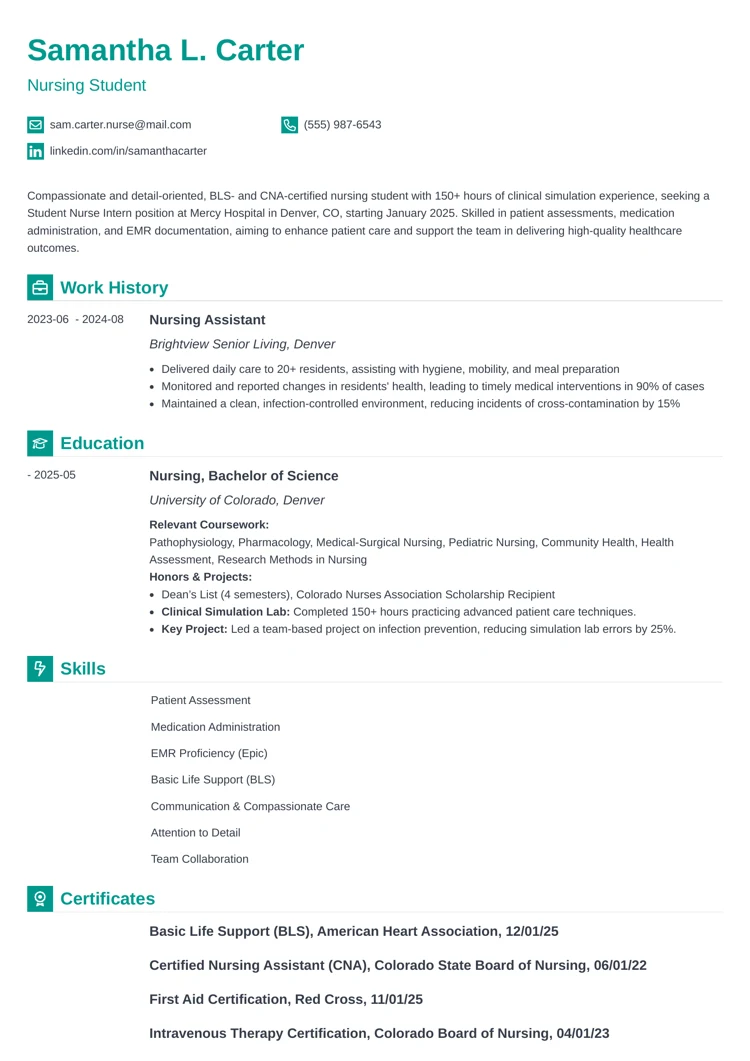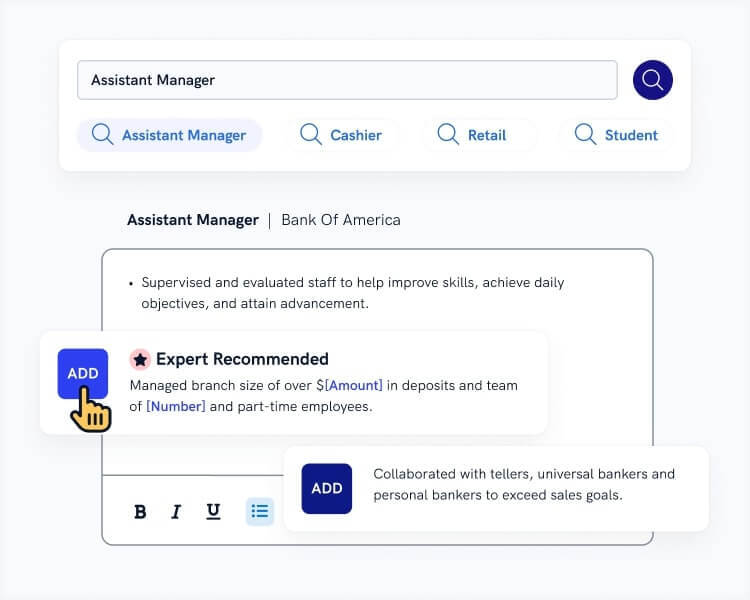Gaining work experience while studying? That’s a fantastic idea! But not all employers are keen on hiring students. It might take some convincing to get a decent job.
Here’s what you must do: turn your student resume into your bargaining chip. You don’t need to know resume-writing fundamentals by heart—just choose one of the resume examples for students below and follow my tips to tailor it to the job you want.
Top Article Insights:
- Student resume example & template you can copy & paste, plus tips to help you personalize it.
- Additional resume examples for high school students, college students, undergraduate students, and more.
- Step-by-step instructions on how to write a student resume.
Student Resume Example
Create Your Student Resume Now
Student Resume Template to Copy & Paste (Text Version)
Harmony Blackwell
Linguistics Student
(111) 111–1111
harmony.blackwell@email.com
linkedin.com/in/harmonyblackwell
Summary
Empathetic linguistics student with advanced Spanish proficiency. Eager to deliver professional translations and support customers with interpreting services at Ventura Languages. Delivered consecutive interpretations for conference speakers as well as the local Spanish-speaking community on a volunteer basis.
Experience
Visitor Center Attendant
Olivas Adobe Park, Ventura, CA
June–September 2024
Key responsibilities:
- Demonstrated excellent customer care skills while handling client inquiries.
- Coordinated visits for Spanish-speaking groups and served as a tour guide, receiving excellent feedback from all participants.
- Created engaging website and social media content in Spanish to attract more visitors.
- Collaborated with a team of four attendants and external travel agencies to guarantee excellent visitor experience at all times.
Key achievements:
- Translated over 30 pages of promotional material within a tight deadline while following strict quality standards.
- Provided consecutive interpreting services during a conference featuring four Spanish-language speakers and 100+ attendees.
Education
B.A. in Linguistics
California State University Channel Islands
Expected graduation in June 2026
- GPA: 3.87
- President of the Poetry Translation Club since January 2024
Skills
- English-Spanish translation
- Consecutive interpretation
- Using CAT tools
- Transcribing
- Editing machine translation
- Verbal and written communication
- Interpersonal skills
- Organization skills
Languages
- Spanish—Advanced (C1)
- Portuguese—Intermediate (B2)
Volunteer Work
- Provided translation and interpretation services on a volunteer basis for over 100 local Spanish-speaking residents since June 2021.
Interests
- Running an Instagram account dedicated to learning Spanish vocabulary and slang words
High School Student Resume Example
Here’s Why I Recommend This Example:
Not all employers want to hire students, so you must appear professional. Trust me, starting your resume with a profile summary that features relevant experience and knowledge is a great way to convince you’re qualified for the job. Additionally, each section of this student resume example features transferable skills that are essential to many entry-level and part-time jobs. Plus, this simple resume design is our users’ favorite, as it appeals to all industries and positions.
See how to make an effective High-School Resume
College Student Resume Example
I Recommend This Example for the Following Reasons:
If you want to compete with more experienced candidates, your college student resume must catch attention straight away. This modern resume design uses simple visuals and bold colors to encourage recruiters to read it till the end. I think that the resume introduction at the top is very effective—it’s tailored to the job by explaining how the applicant wants to contribute to the target company. Since this candidate has only internship experience, they moved the education section above experience to present relevant qualifications. All resume sections are neatly organized, highlighting their attention to detail.
Learn more about writing a professional College Student Resume
Undergraduate Student Resume Example
Why Do I Recommend This Example? (Expert’s Take)
This undergraduate student resume belongs to a young data scientist with some relevant work experience. Noticed how their descriptions of past responsibilities use action verbs such as created and developed? It’s an easy way to highlight initiative. This sample student resume features many resume keywords—I always recommend distributing them evenly in all sections of the resume. Additionally, the selected resume layout is simple and effective, highlighting the candidate’s efficiency and professionalism.
Find out more about writing an Undergraduate Student Resume Example
Nursing Student Resume Example
Here’s My Take on This Resume Example
This nursing student resume sample works perfectly on many levels. It shows candidate’s certifications at the top so that any hiring manager can find them in seconds. You should try the same approach too, so there are no doubts about your qualifications. I think the selected layout works great as well: the tiny resume icons help to spot the beginning of each section, and the overall look is clean and organized.
Learn how to write it from scratch here: Nursing Student Resume Example
Want to see more resume examples for students? Check these:
- High School Graduate Resume Example
- Law Student Resume Example
- Engineering Student Resume Example
- Student Teacher Resume Example
- Student Athlete Resume Example
- College Graduate Resume Example
- College Freshman Resume Example
- Internship Resume Example
Creating a resume with our builder is incredibly simple. Follow our step-by-step guide and use content from Certified Professional Resume Writers to have a resume ready in minutes.
When you’re done, our AI resume builder will score your resume, and our resume checker will show you exactly how to improve it.
How to Write a Student Resume?
If resume examples aren’t enough for you, that’s perfectly fine. I get it—you want some expert advice so you can write your own student resume. First, let’s glance at statistics from student resumes created by Zety users to see what your competitors do:
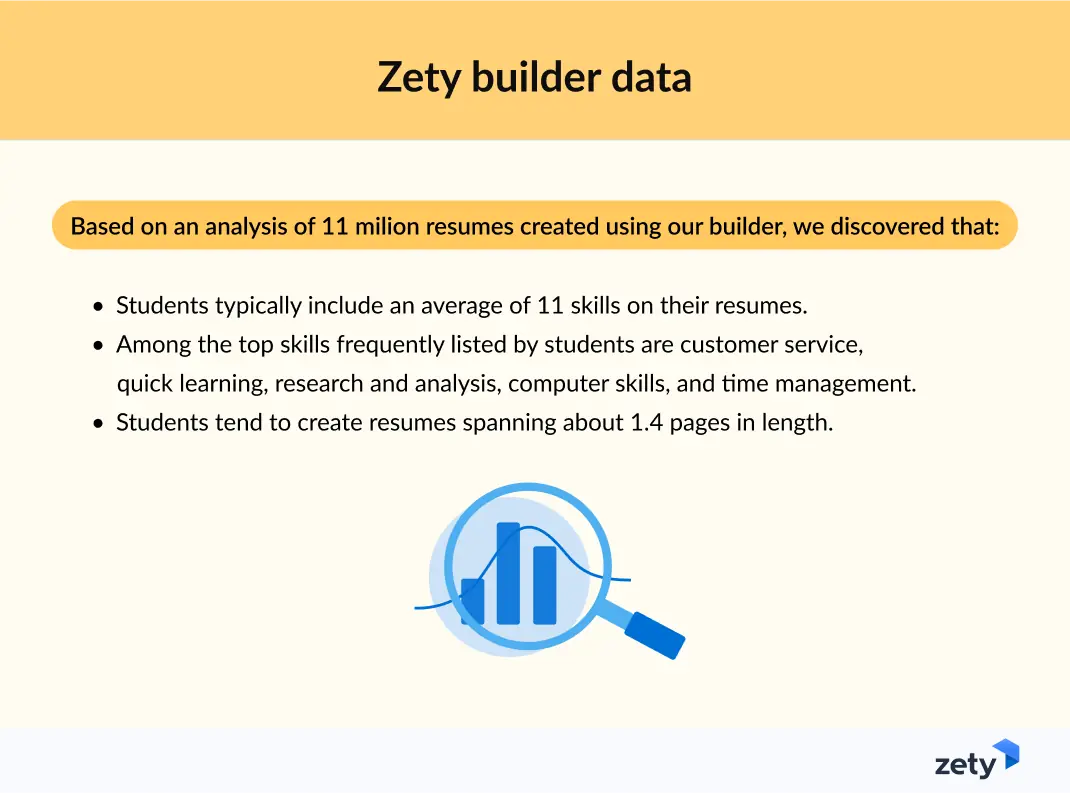
1. Make Your Student Resume Format Professional
Would you turn in a sloppy assignment? It’s the same with a resume—it can’t look as if your dog chewed on it. Formatting your student resume professionally shows you’re serious about the job.
Format your student resume template this way:
- Length: A one-page resume is best for students.
- Fonts: Go for traditional choices such as Georgia, Times New Roman, or Arial.
- Font size: 11–12 for paragraphs, 13–14 for headings.
- Margins: 1 inch on all sides.
- Spacing: 1.0–1.15 is best.
- File format: Save as PDF, unless the job ad mentions a different file type.
- Resume format: Chronological resume format works best, plus put education first if you have no work experience.
Pro Tip: If you have a lot of freelance experience, you can use the skills-based format. It works especially well in creative sectors by highlighting skills and professional achievements.
2. Present Relevant Experience on a Resume for Students
It’s fine that your work history is limited, part-time or freelance; after all, it’s just around 42% of full-time students who also work. If you describe your work activities the right way, they can still impress employers. Don’t focus on listing tasks you performed—focus on showing their results.
How to describe student work experience:
- Start with the most recent job
- List your job title, company name, location, and work period.
- Add 3–6 bullet points describing your responsibilities.
- Start each line with an action verb, and use measurable achievements.
Visitor Center Attendant
Olivas Adobe Park, Ventura, CA
June–September 2024
Key responsibilities:
- Demonstrated excellent customer care skills while handling client inquiries.
- Coordinated visits for Spanish-speaking groups and served as a tour guide, receiving excellent feedback from all participants.
- Created engaging website and social media content in Spanish to attract more visitors.
- Collaborated with a team of four attendants and external travel agencies to guarantee excellent visitor experience at all times.
Key achievements:
- Translated over 30 pages of promotional material within a tight deadline while following strict quality standards.
- Provided consecutive interpreting services during a conference featuring four Spanish-language speakers and 100+ attendees.
Pro Tip: Use accomplishment statements to keep descriptions snappy and impactful. Here’s one formula: Action Word + Context = Result. Another one is PAR: Problem + Action = Result
3. Show Education the Right Way
The education section is a must on a student’s resume. Fill it with relevant information to show employers your knowledge and qualifications for the job.
Include the following information:
- Your highest level of education (e.g., degree or high school graduation)
- University or school name
- Graduation year, years of study, or expected graduation
- GPA, if over 3.5
- Relevant coursework (connected to the position you want)
- Academic honors (e.g., magna cum laude, Dean’s List, competitions)
- Extracurricular activities (e.g., student clubs, volunteering)
B.A. in Linguistics
California State University Channel Islands
Expected graduation in June 2026
- GPA: 3.87
- President of the Poetry Translation Club since January 2024
It’s common practice to put the education section at the top of a student’s resume. I recommend doing that when you’re applying for popular student-friendly jobs or internships—especially if you have little to no work experience. Pulling focus to your educational accomplishments can help convince hiring managers that you’re a hard worker and a high-achiever.
4. Choose Skills for Student Resumes
In a resume for student jobs, the skills section must reflect the job requirements. Your key skills aren’t all the competencies you have—they’re the ones that this specific employer seeks right now.
You can get inspired by these common student skills:
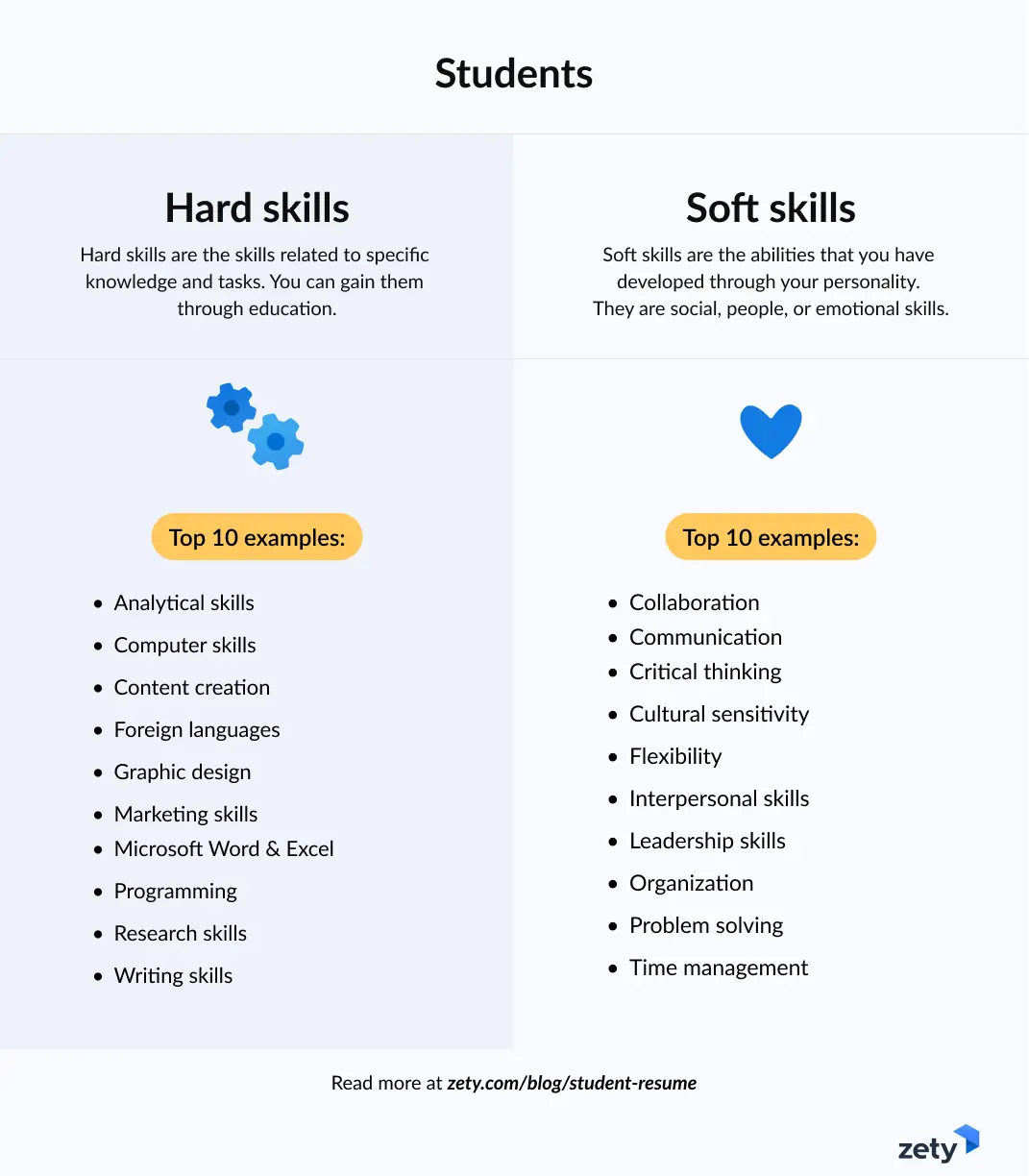
Pro Tip: According to our study, the 3 most common skills on resumes in the U.S. are: teamwork & collaboration, problem solving, and time management. These soft skills are in high demand across industries and positions.
5. Pick Additional Sections for a Student Resume
Give your resume an extra boost using extra sections. They can help you highlight additional strengths as well as help the employer imagine you better. Choose from the following:
- Certifications & Licenses, such as First Aid, Adobe Creative Cloud, Microsoft Office
- Language Proficiency, especially if it’s higher than the B1 level
- Research & Publications, e.g., articles in science journals
- Conferences, especially if you presented as one of the speakers
- Volunteer Experience, such as organizing fundraisers or helping with administrative tasks
- Interests & Hobbies: only if they’re relevant to the job you’re targeting.
Languages
- Spanish—Advanced (C1)
- Portuguese—Intermediate (B2)
Volunteer Work
- Provided translation and interpretation services on a volunteer basis for over 100 local Spanish-speaking residents since June 2021.
Interests
- Running an Instagram account dedicated to learning Spanish vocabulary and slang words
Pro Tip: Keep all information relevant! You might be a dedicated quantum physics student working on extensive research, but if you’re applying for a fast-food cashier job, there’s no point in mentioning your academic work in-depth. Instead, highlight activities that support your people skills and time management.
6. Combine Your Strengths into a Resume Profile
After filling in all the sections, select the best parts of your student resume. Add them all together, and re-write a little to create a career objective or a resume summary. They will help you introduce yourself to a potential employer.
That’s how you write a resume intro:
- Start with a personality adjective, e.g., empathetic or dedicated.
- Mention your studies or a job title.
- Add your background or experience.
- Throw in a key achievement.
- Finish by saying how the company would benefit from your work.
Empathetic linguistics student with advanced Spanish proficiency. Eager to deliver professional translations and support customers with interpreting services at Ventura Languages. Delivered consecutive interpretation for conference speakers as well as the local Spanish-speaking community on a volunteer basis.
Pro Tip: Generally, resume summaries work better than objectives. Employers prefer to know what you could bring to the table. They’re less into knowing what you want to gain from working.
7. Pair Your Student Resume With a Cover Letter
Writing a cover letter significantly boosts your chances of getting an interview invite. Even if you’re not too happy about spending extra time on one, it can help you save it in the long run—the sooner you get the job, the quicker you’ll start earning.
Structure your cover letter this way:
- Start by talking directly to the hiring manager (e.g., “Dear Jordan”).
- Show your enthusiasm for the job.
- Present your strengths and/or achievements that match the job requirements.
- Convince the employer that you’re the person they’re seeking.
- Finish the letter proposing to get in touch.
Here’s an example opening for a college student cover letter:
“Dear Jordan,
While helping my neighbors and other Spanish-speaking residents of the Del Sol neighborhood, I’ve learned how difficult life can be for those who aren’t fluent in the local language. This experience made me understand how important translation and interpretation services are, as clients’ lives truly depend on them. I’m sure that this empathetic approach, paired with my Spanish language proficiency, will make me a valuable asset to Ventura Languages.”
Pro Tip: Use matching resume and cover letter designs, so your job application has a harmonious, polished look.
Plus, a great cover letter that matches your resume will give you an advantage over other candidates. You can write it in our cover letter builder here. Here's what it may look like:
See more cover letter templates and start writing.
Expert’s Video: Tips for Student’s Resume
Do you learn best from instructional videos? Our Certified Professional Resume Writer, Caio made this helpful video explaining how to write a student resume in 5 minutes:
About Zety’s Editorial Process
This article has been reviewed by our editorial team to make sure it follows Zety's editorial guidelines. We’re committed to sharing our expertise and giving you trustworthy career advice tailored to your needs. High-quality content is what brings over 40 million readers to our site every year. But we don't stop there. Our team conducts original research to understand the job market better, and we pride ourselves on being quoted by top universities and prime media outlets from around the world.
